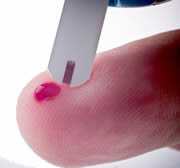Monitoring your own glucose is done with a Glucose Meter. Self-monitoring is often called SMBG (self-monitoring of blood glucose). Glucose meters today are small, battery-operated devices.
A sample of blood
When you want to test for glucose with a glucose meter you need to place a small sample of your blood on a test strip. Your skin is pricked with a lancet - like a very fast pin-prick.
These test strips are disposable. You then place the strip in the monitor. The strips are coated with glucose dehydrogenase or hexokinase that combines with glucose in blood.
The blood is usually taken from a finger, but some meters allow the use of other parts of the body to supply the blood sample.
How the meter works
The meter tells you how much glucose is present in your blood. How meters do this may vary. With some meters a measurement of the amount of electricity that passes through your blood sample is measured, while others measure the degree of reflection of light. The glucose level is displayed as a number. In the case of this picture (below right) the person's glucose level is low. Many of the new meters can store a series of test results, while others can be connected to your personal computer to store results, which you can also print out.
How to choose a glucose meter
According to the FDA there are 25 different meters on the market. They are not all the same. You should bear the following in mind when choosing one:
- Testing speed
- Size
- Memory (ability to store results)
- Price
The newer models have automatic timing, error codes and signals, barcode readers to help with calibration. Some have spoken instructions for people who are visually impaired.
Using your meter
Frequency of meter usage varies significantly from patient-to-patient. It is important that you adhere to the instructions given to you from your health care provider. Every person with diabetes should be self-monitoring his/her blood glucose - this is especially so for people who are taking insulin.
According to the American Diabetes Association (ADA), patients with Type 1 should self-monitor blood glucose at least three times per day.
The ADA says that women with gestational diabetes (diabetes during pregnancy) should self-test twice a day.
There is no general recommendation from the ADA regarding frequency of self-testing for Type 2 patients.
Most patients who do have to self-test will generally have to do so before meals, a couple of hours after meals, at bedtime, 3.a.m., and whenever signs or symptoms are felt.
When a patient changes medication testing should be carried out more frequently.
If you have an unusual illness or sudden stress, you should test more frequently.
Knowing how to use your meter
As meters work in different ways you should get training from a diabetes educator.
Using a glucose meter - instructions
- Wash your hands with warm water and soap. Dry completely. You could also dab or wipe the area with alcohol and then dry completely.
- Use the lancet to prick your fingertip.
- Hold your hand down. Hold your finger at the same time until you see a small droplet of blood appear.
- Place the blood on the test strip.
- Follow the instructions for placing the test strip and using your meter.
- Keep a record of your result.
Many regulatory authorities, such as the FDA, require that meters and test strips come with instructions. It is important that you become familiar with these instructions, which should be included in the User Manual. Some meters give out an error code if something is wrong. Checking the User Manual will tell you what the error code means.
In many countries the User Manual will have a toll free number. If you call and cannot get through call your health care provider or your local emergency room. Check out the website of the manufacturer. The FDA advises patients to visit the manufacturer's website regularly for any updates or issues.
Getting the Most Out of Blood Glucose Meters
=====0oo0=====
Next Page: How is diabetes managed? - >


No comments:
Post a Comment